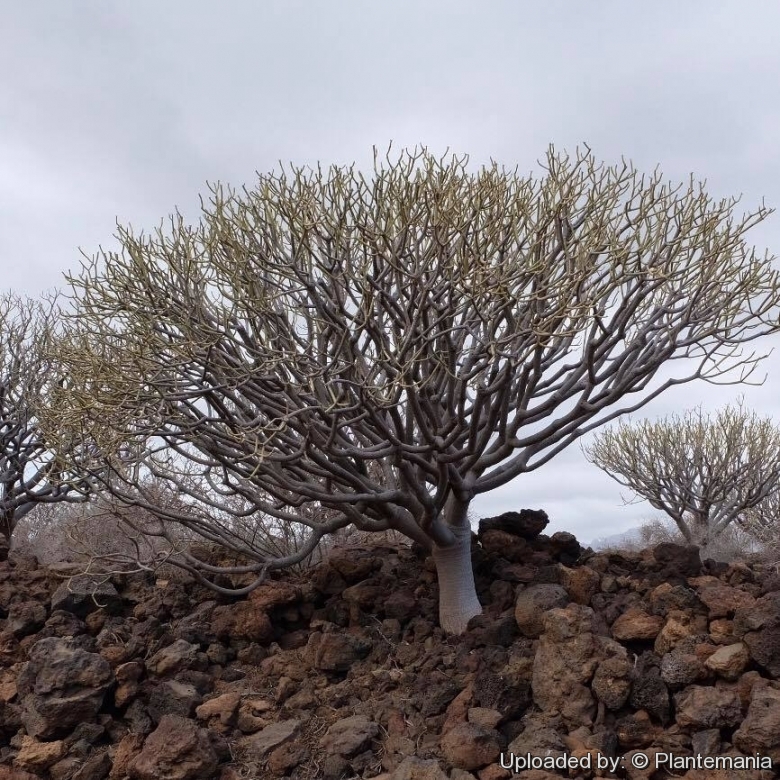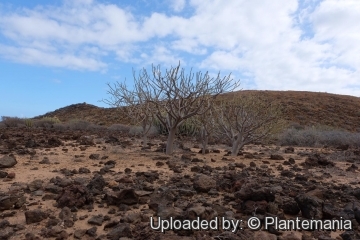
Euphorbia lamarckii Photo by: © Plantemania
Growing habit near Tenerife, Canary Islands, Spain, 14 February 2018.
Origin and Habitat: Western Canary islands, Spain( El Hierro, La Palma, La Gomera, Teneriffa), Mauritania and South-West Morocco. In Tenerife this species can be found on the north coast in the Orotava Valley, Bu ena Vista and Masca. From Puerto de la Cruz, it can be discovered on the coastal path to the Playa del Bollullo, where it colonizes several smaller barrancos. On the east coast of La Palma, this species extends from Santa Cruz via Mazo to Fuencaliente, in the north there are beautiful stocks in the Garafia region. On La Gomera you can see the plant mainly in the Gran Rey Valley and on El Hierro and also in La Dehesa in the neighborhood of the famous Juniper trees.
Habitat and ecology: Euphorbia lamarckiiSN|17339]]SN|34888]] is a widespread species that grows from near the sea in the lower slopes of coastal hills to the pine forest region at altitudes up to 1000 metres. It occurs together with Euphorbia balsamiferaSN|34888]]SN|17339]], Artemisia thuscula and Kleinia neriifoliaSN|19319]]SN|19319]] (syn. Senecio kleiniaSN|19315]]SN|19315]])
Synonyms:
See all synonyms of Euphorbia lamarckii
back
Accepted name in llifle Database:Euphorbia lamarckii SweetHort. Suburb. Lond. 107 1818.Synonymy: 11
back
Common Names include:
ENGLISH: wild tabaiba
GERMAN (Deutsch): Lamarcks Wolfsmilch, Stumpfblättrige Wolfsmilch
SPANISH (Español): Tabaiba amarga, Higuerilla, Tabaiba salvaje, Tabaiba, Heriguilla, Tabaiba morisca
Description: With a height of 0.8-2.5 metres, Euphorbia lamarckiiSN|34888]]SN|34888]] is one of the largest Canarian spurges that forms large shrubs or small trees with woody trunks. Its nomenclature has been controversial. E. lamarckii Sweet is the name that according to the last list of wild species of the Canary Islands, should prevail over that of Euphorbia obtusifolia Poir. and Euphorbia broussonetii. It belongs to the group of endemic shrub species. It differs from other species by its pedunculated, umbelliform and usually compound inflorescences, yellow-greenish in colour and because the floral bracts fall off before the fruit ripens. The yellowish-green floral bracts and narrow lanceolate leaves with rounded tips are very similar to the king Juba spurge (Euphorbia regis-jubae) that spread on the eastern islands, but their distributions do not overlap.
Derivation of specific name: This species bears the name of the French botanist and zoologist Jean Baptiste de Lamarck (1774-1829), who became one of the most influential biologist by introducing the term "biology" and an early proponent of the idea that biological evolution occurred and proceeded in accordance with natural laws.
Stems: Light brown, old basal stem parts more or less thickened, with dark slightly rough bark; Branches in whorls, fleshy.
Leaves: Densely crowded at branches tips, linear, to 75 mm long and 6 mm wide, glaucous, sessile.
Inflorescences: The inflorescence is usually a terminal 4- to 7-rayed compound umbel, rays to 18 mm long. Bracts ovate, small. Nectar-glands elliptic, greenish-yellow, more or less 2-lobed.
Blooming season: Euphorbia lamarckiiSN|34888]]SN|34888]] flowers in profusion in winter and spring (February to June).
Fruits: Obtusely lobed, ca. 8 mm across, glabrous. Pedicels exserted.
Seeds: The elaiosome (caruncle) attached to a seed is sessile or has only a very short stalk.
Bibliography: Major references and further lectures
1) Urs Eggli "Illustrated Handbook of Succulent Plants: Dicotyledons" Volume 2. Springer, 2002
2) Rolf Goetz “Flora der Kanarischen Inseln: Mit GPS-Daten zu Pflanzenstandorten zum” Bergverlag Rother GmbH, 10 May 2017
3) Euphorbia lamarckii Sweet in: González, Manuel Luis Gil (2018), Flora Vascular de Canarias, web: http://www.floradecanarias.com/euphorbia_lamarckii.html
4) Bramwell, David & Bramwell, Zoë (2001), “Wild Flowers of the Canary Islands” (2nd ed.), Madrid: Editorial Rueda
5) Molero, Julián & Rovira, Anna Maria (2004), "Euphorbia lamarckii Sweet, correct name for E. obtusifolia Poir. non Lam." (PDF), Vieraea, 32: 117–122, web: http://www.azoresbioportal.angra.uac.pt/files/publicacoes_Vieraea_32_2004_10.pdf
 Growing habit near Tenerife, Canary Islands, Spain, 14 February 2018. Photo by: © Plantemania
Growing habit near Tenerife, Canary Islands, Spain, 14 February 2018. Photo by: © PlantemaniaSend a photo of this plant.The gallery now contains thousands of pictures, however it is possible to do even more. We are, of course, seeking photos of species not yet shown in the gallery but not only that, we are also looking for better pictures than those already present.
Read More...











